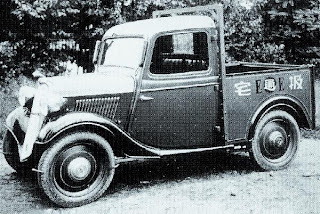The Datsun 14T was a small truck based on the 1935 Datsun 14 sedan.
The previous Datsun 13t truck differed from the sedan in that it used a rather plain painted radiator grille rather than the ornate grille of the sedan. All that changed in 1935 when the Datsun 14T truck used the entire front section of the 14 sedan, including it's beautiful and ornate love heart shaped chrome plated grille.
The Datsun 14T also used the new "leaping bunny rabbit" emblem that was fitted to the Datsun 14 sedan for the first time. In the years before the Datsun name arrived, the company building these cars was called DAT. The company was named DAT to honour the original investors in the company. DAT was the initials of the surnames of the three investors, Den, Aoyama and Takeuchi. DAT also happened to be the Japanese word for hare, or fast rabbit. In 1935 Nissan decided to make the most of the rabbit accociation, and to incorporate a rabbit into the design of the new Datsun 14. Ryuichi Tomiya designed a beautiful leaping rabbit radiator mascot for the Datsun 14, which was along the same lines as the Lincoln Greyhound mascot and the later Jaguar leaping cat. Sadly this beautiful and distinctive feature was only used on the Datsun 14 and 14T.
Much of the body of the Datsun 14T was pretty much the same as that of the previous Datsun 13T, the main difference being that the bonnet is shorter thanks to the use of the sedan's sloping grille. Mechanically she was different though. The old DAT engine of the Datsun 13T was replaced with the new Datsun Type 7 engine, which was a side valve 4 cylinder engine with a displacement of 722cc. The new engine was actually slightly smaller than the old DAT engine, but at 15hp it was more powerful.
The Datsun 14T was in production from April 1935 until April 1936.
































